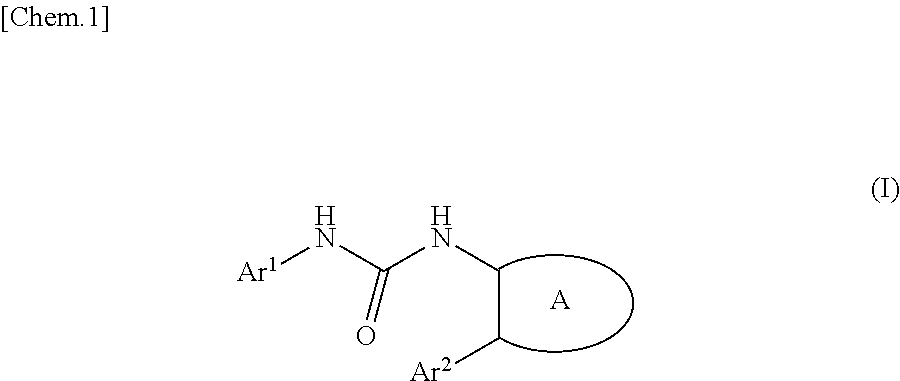Urea derivative or pharmacologically acceptable salt thereof
- Summary
- Abstract
- Description
- Claims
- Application Information
AI Technical Summary
Benefits of technology
Problems solved by technology
Method used
Image
Examples
reference example 1-1
[0482]
Methyl 2,2-dimethyl-4-{[(trifluoromethyl)sulfonyl]oxy}-2,5-dihydrofuran-3-carboxylate
[0483]Under an argon atmosphere, to ice-cooled diethyl ether (43 mL) were added sodium hydride (746 mg) and then methyl 2,2-dimethyl-4-oxotetrahydrofuran-3-carboxylate (2.36 g), and the mixture was stirred for 30 minutes. Then, trifluoromethanesulfonic anhydride (2.83 mL) was added to the mixture to produce a reaction solution. The reaction solution was stirred under ice-cooling for 4 hours. To water was added the reaction solution, the mixture was extracted with dichloromethane, and the extract was dried over anhydrous sodium sulfate. The solvent was removed under reduced pressure, and the residue was then purified by silica gel column chromatography (hexane:ethyl acetate=20:1-1:1) to obtain the title compound as a colorless oil (3.43 g).
[0484]1H NMR (400 MHz, CDCl3) δ: 1.52 (6H, s), 3.84 (3H, s), 4.69 (2H, s).
reference example 1-2
[0485]
Methyl 4-{[(trifluoromethyl)sulfonyl]oxy}-2,5-dihydrothiophene-3-carboxylate
[0486]Using methyl 4-oxotetrahydrothiophene-3-carboxylate instead of methyl 2,2-dimethyl-4-oxotetrahydrofuran-3-carboxylate, the same method as in Reference Example 1-1 was performed to obtain the title compound.
[0487]1H NMR (400 MHz, CDCl3) δ: 3.83 (3H, s), 3.94-3.99 (4H, m).
reference example 2-1
[0488]
Methyl 4-(4-methoxyphenyl)-2,2-dimethyl-2,5-dihydrofuran-3-carboxylate
[0489]Under an argon atmosphere, to a solution of methyl 2,2-dimethyl-4-{[(trifluoromethyl)sulfonyl]oxy}-2,5-dihydrofuran-3-carboxylate (3.41 g) in N,N-dimethylformamide (62 mL) were added (4-methoxyphenyl)boronic acid (1.70 g), triethylamine (4.68 mL), and tetrakis(triphenylphosphine)palladium (386 mg) to produce a reaction solution. The reaction solution was stirred at 100° C. for 3 hours. 1 mol / L Hydrochloric acid was added to the reaction solution to make the reaction solution acidic (pH: 1), and the mixture was extracted with ethyl acetate. The organic layer was washed with water and then a brine, and dried over anhydrous sodium sulfate. The solvent was removed under reduced pressure, and the residue was then purified by silica gel column chromatography (hexane:ethyl acetate=20:1-1:2) to obtain the title compound as a colorless oil (2.55 g).
[0490]1H NMR (400 MHz, CDCl3) δ: 1.53 (6H, s), 3.69 (3H, s), 3....
PUM
| Property | Measurement | Unit |
|---|---|---|
| Volume | aaaaa | aaaaa |
| Volume | aaaaa | aaaaa |
| Volume | aaaaa | aaaaa |
Abstract
Description
Claims
Application Information
 Login to View More
Login to View More - R&D
- Intellectual Property
- Life Sciences
- Materials
- Tech Scout
- Unparalleled Data Quality
- Higher Quality Content
- 60% Fewer Hallucinations
Browse by: Latest US Patents, China's latest patents, Technical Efficacy Thesaurus, Application Domain, Technology Topic, Popular Technical Reports.
© 2025 PatSnap. All rights reserved.Legal|Privacy policy|Modern Slavery Act Transparency Statement|Sitemap|About US| Contact US: help@patsnap.com



